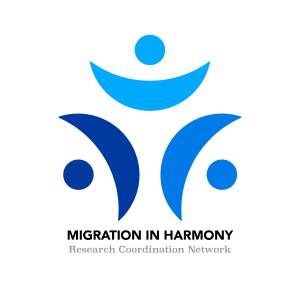By: Victoria Herrmann, The Arctic Institute, President and Managing Director

Migration in Harmony (MiH) is a Research Coordination Network (RCN) on Arctic migrations funded by the National Science Foundation (NSF). We work to synthesize current research, jointly identify and prioritize research topics, and build collaborative project teams to support a resilient, just, and sustainable Arctic in motion.
Our three-year international, cross-disciplinary network is led by Principal Investigator (PI) Victoria Herrmann, Assistant Research Professor at Georgetown University and Managing Director of The Arctic Institute, co-PI Dr. Chad Briggs, Director of Public Policy and Administration at the University of Alaska Anchorage, and Dr. Elizabeth Ferris, a Research Professor with the Institute for the Study of International Migration at Georgetown University's School of Foreign Service. Our network of over 530 members from 40+ countries includes traditional knowledge holders, natural scientists, engineers, students, humanities scholars, economists, social scientists, storytellers, engineers, health professionals, practitioners, and educators working on the many dimensions of Arctic migration.

From the hunter-gatherer populations who traversed across Siberia and into Beringia during the Late Pleistocene period to the 21st century Sami reindeer herders across Sápmi in northern Europe, the Arctic has been on the move for millennia. And yet, the accelerated pace of ecological, societal, and climate changes today is introducing a new normal for the Arctic with new, at times unpredictable, patterns of movement for peoples, economies, and species. Our RCN aims to facilitate open communication, foster cross-disciplinary exchange, and build new collaboration teams of scientists, stakeholders, and practitioners to investigate our organizing question: What are the ways in which the drivers and consequences of Arctic coastal migrations intersect and interact with one another, and what are the implications for society?
Urbanization, globalization, and the impacts of climate change are activating the simultaneous migrations of species, ecosystems, settlements, and cultures across Arctic coastlines in new and unpredictable ways. Arctic port cities are witnessing increased maritime traffic and inflow of migrant labor; rural villages are facing displacement from slow and sudden-onset disasters; sea-ice melt and ocean warming are shifting marine species ranges; and terrestrial ecosystems in transition are upending Arctic food webs and introducing southern disease vectors.
Each of these intersecting mobilities challenge the quality of life, sustainable development, and environmental health of the circumpolar north. A lack of integration across siloed research communities has hampered the expansion of knowledge to understand these interactions and provide decision makers and stakeholders with the necessary qualitative and quantitative data to make science-informed decisions. The MiH-RCN wants to change that by building an Arctic community to share ideas, support students, and collaborate on migration projects.
MiH-RCN will advance knowledge on how the migrations of Arctic ecosystems, economies, peoples, and cultures interact with one another, and how the social, geohazard, and economic drivers and consequences of migrations intersect across different fields. We do this by: (1) engaging local leaders, practitioners, and researchers from diverse disciplines in North America and Europe to bridge research divides and synthesize existing data, (2) linking ongoing major research initiatives to fill this research gap, and (3) implementing creative participatory methods to broaden participation in migration research.
From high school students at Mt. Edgecumbe High School in Sitka to graduate students in the SURGE Design and Development Launch Pilot from NSF INCLUDES, MiH-RCN is dedicated to elevating student involvement and voices. And by having collaborators in Canada, Iceland, Norway, Sweden, Finland, Russia, and Indigenous leaders, our networking is strengthening international collaboration. In addition to mentorship, science communication, and outreach workshops for students, the network is also running an Arctic Winter College in 2021 to build a lasting, policy-oriented network of Arctic professionals to strengthen communication between peoples and nations, scientific disciplines, policy areas, and across the science-policy interface to improve collaborations, research, and decision-making in the Arctic.
Since the start of our Network in May, we have held 10 virtual events with many more scheduled for the next few months. And over the next three years, we will be hosting three annual meetings in Anchorage, Stockholm, and Washington, DC, dependent on the safety of in person gatherings. Year One will focus on sense-making—the process of understanding Arctic migrations, examining why their systemic interactions are important, and co-creating a network vision and values. We will invite participants, synthesize existing research projects, and initiate integrative dialogues across disciplinary and country borders. This will culminate in the annual meeting, where participants will be tasked to see the interactions, interdependencies, and intersections of Arctic coastal systems in movement through a participatory workshop. Year Two will focus on identifying gaps in collaborative migration research, map emerging patterns of movement, and share ideas that could transform the public domain. We will continue to broaden and deepen the network, both inviting new participants and strengthening existing collaborations. This will culminate in the annual meeting, where participants will be tasked to co-develop an Arctic coastal migration scenario, which will then be simulated through together as a table-top exercise. Year Three will focus on creating partnerships, facilitating new resource flows, and submitting collaborative grant applications to fill research gaps in Arctic coastal migrations. While continuing to invite new participants, our focus will shift to activities and strategic planning for long-term sustainability of the network's synergies, relationships, and synthesis work. This will culminate in the annual meeting, where participants will be tasked to form integrated, multi-disciplinary research teams around the prioritized research topics and capacity building.
This network is founded on the vision that sustainable, equitable, and science-driven decisions are best made when we work together—including you! To join our network, please visit our website, Migration in Harmony. For questions, please contact Victoria Herrmann at The Arctic Institute (Victoria.herrmann [at] thearcticinstitute.org).
About the Author
 Dr. Victoria Herrmann is the Managing Director of The Arctic Institute, where she researches climate change impacts and adaptation. As an Assistant Research Professor at Georgetown University, Victoria serves as the Principle Investigator of the National Science Foundation funded Arctic Migration in Harmony, a major international initiative to integrate discipline-isolated research on changing Arctic migration patterns. Victoria also studies climate-induced displacement in North America and Fiji as a National Geographic Explorer. In her project America's Eroding Edges, she traveled across the country interviewing 350 local leaders to identify what's needed most to safeguard coastal communities against the unavoidable impacts of climate change. Her current initiative, Rise Up to Rising Tides, is creating an online matchmaking platform that connects pro bono experts with climate-affected communities. She serves on the Board of Directors for ARCUS and the Arctic Youth Networks and as an IF/THEN Ambassador for the American Association for the Advancement of Science. She was a Junior Fellow at the Carnegie Endowment, a Canada Fulbright Awardee, a Mirzayan Science and Technology Policy Fellow at the National Academies of Sciences, and a Gates Scholar at the University of Cambridge, where she received her PhD in Geography.
Dr. Victoria Herrmann is the Managing Director of The Arctic Institute, where she researches climate change impacts and adaptation. As an Assistant Research Professor at Georgetown University, Victoria serves as the Principle Investigator of the National Science Foundation funded Arctic Migration in Harmony, a major international initiative to integrate discipline-isolated research on changing Arctic migration patterns. Victoria also studies climate-induced displacement in North America and Fiji as a National Geographic Explorer. In her project America's Eroding Edges, she traveled across the country interviewing 350 local leaders to identify what's needed most to safeguard coastal communities against the unavoidable impacts of climate change. Her current initiative, Rise Up to Rising Tides, is creating an online matchmaking platform that connects pro bono experts with climate-affected communities. She serves on the Board of Directors for ARCUS and the Arctic Youth Networks and as an IF/THEN Ambassador for the American Association for the Advancement of Science. She was a Junior Fellow at the Carnegie Endowment, a Canada Fulbright Awardee, a Mirzayan Science and Technology Policy Fellow at the National Academies of Sciences, and a Gates Scholar at the University of Cambridge, where she received her PhD in Geography.
